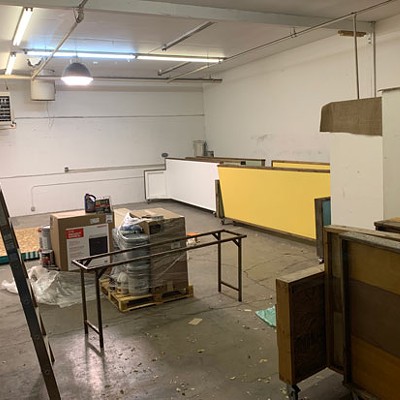Every artist has a process. For many, an intentional studio space, the right supplies, and a spark of creativity are all that's needed to embark on a new project. For artist Barbara Hudin, whose "Beautiful Math" exhibit runs through March 29 at A6 (389 SW Scalehouse, Suite 120), her creative process is a journey through mathematic theorems, computer programming, algorithms, photo-sensitive polymer plates, and multi-process printmaking. Hudin's showcased work—referred to as "generative art" because she uses computer algorithms to generate visual images—combines the natural world with the technical language of code. The effect is ethereal, dimensional, multi-layered imagery that represents Hudin's mathematical and artistic prowess.
The daughter of a mural and advertising painter in San Francisco, Hudin was set on a path early in life—though, surprisingly, not an artistic one.
"I always wanted to be an artist; my father was an artist," said Hudin. "From him, I realized I needed to have a different career."
She had an aptitude for math, which led her to a mathematics major and successful career in computer programming. After her early retirement in the 1990s, Hudin embarked on becoming a full-time artist, attending Pacific Northwest College of Art with a focus in printmaking.
"Even though I'm a printmaker, I still think of myself as a painter who experiments in prints," said Hudin.
A longtime member of the A6 Print Studio, Hudin's printmaking took a fascinating turn in 2011 when she discovered Processing code online and "started playing with it." The creation of MIT students Casy Reas and Ben Fry, Processing is an open-source computer language that creates a platform for graphics and interaction, allowing its users to generate sound, video, and images. Hudin calls Processing "an intriguing way to incorporate math into my art."
"Perhaps [the show] should have been called 'Beautiful Computer Code,'" admitted Hudin.
While Processing code was the launching point for Hudin's "Beautiful Math"—all of the images were created in part or whole using algorithms, or instructions, written in the code—her works reference an array of mathematical theorems and muses, from Pi to Fibonacci to Mandelbrot's fractals and M.C. Escher. Her "Binary Tree" features a stark, bare-limbed tree created in code; its splaying branches reach for a round, full moon created with Hudin's own hand. Thus the artist reveals her intuitive understanding of the harmony between the natural and technological, between the fractal geometry of the tree and the spherical, classic geometry of the moon, and between the computer-generated and the hand-made. At the end of the day, however, said Hudin, "I'm interested in creating a pretty picture."
"I'm a person who essentially sat alone and focused on one thing in life—first my career, and then making art," said Hudin. "I'm doing this for me."









![Get Your Art on the Wall ▶ [with video] (con versión en español)](https://media2.bendsource.com/bend/imager/get-your-art-on-the-wall-with-video-con-version-en-espanol/u/r-bigsquare/12934834/artwatch1.1.jpg?cb=1680199454)













